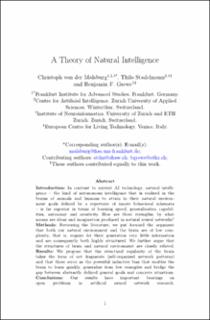Please use this identifier to cite or link to this item:
https://doi.org/10.21256/zhaw-26857Full metadata record
| DC Field | Value | Language |
|---|---|---|
| dc.contributor.author | von der Malsburg, Christoph | - |
| dc.contributor.author | Stadelmann, Thilo | - |
| dc.contributor.author | Grewe, Benjamin F. | - |
| dc.date.accessioned | 2023-02-09T13:33:44Z | - |
| dc.date.available | 2023-02-09T13:33:44Z | - |
| dc.date.issued | 2022-04-22 | - |
| dc.identifier.other | arXiv:2205.00002 | de_CH |
| dc.identifier.uri | https://digitalcollection.zhaw.ch/handle/11475/26857 | - |
| dc.description.abstract | Introduction: In contrast to current AI technology, natural intelligence – the kind of autonomous intelligence that is realized in the brains of animals and humans to attain in their natural environment goals defined by a repertoire of innate behavioral schemata – is far superior in terms of learning speed, generalization capabilities, autonomy and creativity. How are these strengths, by what means are ideas and imagination produced in natural neural networks? Methods: Reviewing the literature, we put forward the argument that both our natural environment and the brain are of low complexity, that is, require for their generation very little information and are consequently both highly structured. We further argue that the structures of brain and natural environment are closely related. Results: We propose that the structural regularity of the brain takes the form of net fragments (self-organized network patterns) and that these serve as the powerful inductive bias that enables the brain to learn quickly, generalize from few examples and bridge the gap between abstractly defined general goals and concrete situations. Conclusions: Our results have important bearings on open problems in artificial neural network research | de_CH |
| dc.format.extent | 17 | de_CH |
| dc.language.iso | en | de_CH |
| dc.publisher | arXiv | de_CH |
| dc.rights | http://creativecommons.org/licenses/by/4.0/ | de_CH |
| dc.subject | Ontogenesis | de_CH |
| dc.subject | Emergence | de_CH |
| dc.subject | Structural regularity | de_CH |
| dc.subject | Net fragment | de_CH |
| dc.subject | Visual perception | de_CH |
| dc.subject | Scene representation | de_CH |
| dc.subject | Homeomorphic mapping | de_CH |
| dc.subject | Inductive bias | de_CH |
| dc.subject | Autonomous behavior | de_CH |
| dc.subject.ddc | 590: Tiere (Zoologie) | de_CH |
| dc.subject.ddc | 610: Medizin und Gesundheit | de_CH |
| dc.title | A theory of natural intelligence | de_CH |
| dc.type | Working Paper – Gutachten – Studie | de_CH |
| dcterms.type | Text | de_CH |
| zhaw.departement | School of Engineering | de_CH |
| zhaw.organisationalunit | Centre for Artificial Intelligence (CAI) | de_CH |
| dc.identifier.doi | 10.48550/ARXIV.2205.00002 | de_CH |
| dc.identifier.doi | 10.21256/zhaw-26857 | - |
| zhaw.funding.eu | No | de_CH |
| zhaw.originated.zhaw | Yes | de_CH |
| zhaw.webfeed | Machine Perception and Cognition | de_CH |
| zhaw.webfeed | Datalab | de_CH |
| zhaw.webfeed | DIZH Fellowship | de_CH |
| zhaw.webfeed | ZHAW digital | de_CH |
| zhaw.author.additional | No | de_CH |
| zhaw.display.portrait | Yes | de_CH |
| Appears in collections: | Publikationen School of Engineering | |
Files in This Item:
| File | Description | Size | Format | |
|---|---|---|---|---|
| 2022_vonderMalsburg-etal_Theory-of-Natural-Intelligence_CogCompPreprint.pdf | 548.44 kB | Adobe PDF |  View/Open |
Show simple item record
von der Malsburg, C., Stadelmann, T., & Grewe, B. F. (2022). A theory of natural intelligence. arXiv. https://doi.org/10.48550/ARXIV.2205.00002
von der Malsburg, C., Stadelmann, T. and Grewe, B.F. (2022) A theory of natural intelligence. arXiv. Available at: https://doi.org/10.48550/ARXIV.2205.00002.
C. von der Malsburg, T. Stadelmann, and B. F. Grewe, “A theory of natural intelligence,” arXiv, Apr. 2022. doi: 10.48550/ARXIV.2205.00002.
VON DER MALSBURG, Christoph, Thilo STADELMANN und Benjamin F. GREWE, 2022. A theory of natural intelligence. arXiv
von der Malsburg, Christoph, Thilo Stadelmann, and Benjamin F. Grewe. 2022. “A Theory of Natural Intelligence.” arXiv. https://doi.org/10.48550/ARXIV.2205.00002.
von der Malsburg, Christoph, et al. A Theory of Natural Intelligence. arXiv, 22 Apr. 2022, https://doi.org/10.48550/ARXIV.2205.00002.
Items in DSpace are protected by copyright, with all rights reserved, unless otherwise indicated.